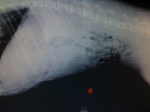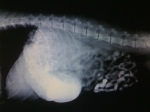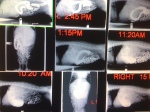Barium Study in a Dog
 Weight Loss, Vomiting, and Intermittent Soft Stool in a German Shepherd Dog
Weight Loss, Vomiting, and Intermittent Soft Stool in a German Shepherd Dog
Frisko panted nervously and looked up at the Doc from underneath steady eyebrows. He doubted he needed to see the doctor. After all, dogs vomit occasionally, right? The 5-year-old male black and tan German Shepherd Dog thought he had everything under control. Except he lost 6 pounds in one month! Oops! Rapid weight loss in a dog for no good reason warrants a trip to the animal hospital.
“I watch him like a hawk and we’re always together. Do you think it’s the twisted stomach again like he had a few years ago?” said Frisco’s dad.
“No, we tacked his stomach that time so it can’t flip anymore. (23% chance the tacking suture breaks down, scientifically speaking.) Besides, those symptoms are sudden and violent, unless there’s a twist that comes and goes on its own, which can be very difficult to diagnose,” said Doc Truli.
Frisco’s complete blood count, 25 blood chemistries, electrolytes, fecal parasite examination and pancreatitis screening test (snap PLI) were normal. His surgery radiographs (x-rays) looked normal.
Yet clearly, there was something very wrong with Frisco.
“The next step is a barium series,” said Doc Truli.
What Is a Barium Study in a Dog?
A metal called liquid barium is fed to the dog. Silly, enthusiastic dogs (like Pit Bull Terriers) will often just eat the stuff out of a bowl, especially if you put a dollop of cat food on top of it. If you’ve ever tasted barium, it has a chalky, metallic taste. The manufacturers mix barium with strawberry flavor to try to mask the taste. Then you get a chalky, metallic, artificial strawberry taste. Bleck!
There are also newer technology beeds impregnated with barium that are easier to swallow and don’t taste bad. The beads are not always appropriate to show details in the lining of the stomach or intestines, like in Frisco’s case. The barium beads are very good to show the motility, or rate of movement of a substance through the intestinal system.
Stuff That Barium Can Miss
- peach pit
- squeaker from a toy
- fabric
- cat toys
- lymphoma
- inflammatory bowel disease
- pancreatitis
- helicobacter gastritis
Frisco donned a towel and ate barium by 2-ounce (60 mL) oral dosing syringe. The barium gets everywhere if you let it! Since metal shows easily on an x-ray as a solid white area, no barium could touch the dog on the outside of his body. Even a tiny smudge of barium on the fur on his side could happen to cover the pylorus or a critical component of his insides and render the study incomplete or invalid. (Another Murphy’s Law of Medicine: a tiny 1 inch (2.2 cm) smudge will line up exactly over the x-ray area of interest) After 5 syringes, he was loaded for the barium study.
Why Does the Barium Study Take All Day?
Once the barium is loaded into the patient, x-rays are taken every 15 minutes to 1 or 2 hours (depending on the problem being investigated.) The idea is this: the barium should move through normally. The stomach and intestines should fill nicely and evenly, and the barium should move through the esophagus immediately, the stomach in 30 minutes to 2 hours tops, the intestines over a few hours.
The whole thing takes about 12 hours to be sure nothing abnormal is missed. Sometimes, you get lucky and the problem is in the beginning of the body, like the stomach, and the barium outlines the abnormality within the first few x-rays. The abnormal outline is called a filling defect because the barium cannot fill the area as expected. This indicates a possible problem. Of course, x-ray interpretation is part science and part art of medicine. Seeing the problem with your own eyes during endoscopy or surgery is the only way to be sure of the interpretation on the barium study. (As we shall see later in Frisco’s story.)
Sometimes your vet will have you come back in the morning after the study for one last x-ray. Why? Because , if there is any barium held up in the system after 24 hours, that is very abnormal and helps diagnose a serious problem.
Plus, Why So Many X-Rays?
(Does my vet just want to charge more? Or, is my vet being over-cautious?)
Well, this is a time-space continuum sort of problem. The x-rays must be taken at the right time to see the problem. Too much time in between, you’ll miss it completely. Too little time, you’ll be in the x-ray room all day.
There’s a special x-ray technology for pets who need real-time x-rays. It’s called fluoroscopy. A fluoroscope is like a special x-ray unit that shows the pictures on a screen as they happen. It is available usually in one or two university and specialty hospitals per state in the US. Fluoroscopy is an excellent diagnostic modality to determine motility disorders, especially megasophagus and hiatal hernias.
Frisco’s Barium Study Was 100% Normal
A possibility with a barium series – or study – is NO abnormalities! X-rays and Barium can miss the spot, miss the problem, slide past the problem, or the problem could be within the muscle walls of the intestines and not show in the lumen – or interior – where the barium is passing through. Every test has its limits!
Frisco underwent abdominal ultrasound next. Ultrasound is non-invasive; there’s no recovery time. The ultrasound could theoretically tell if Frisco has thickened intestinal walls, large abdominal lymph nodes, or other signs of a reason why he was losing weight.
Guess what happened? Everything looked normal! Believe it or not, tests can all be normal in a severely ill dog.
Frisco’s Endoscopy
The next decision was complicated. Should Frisco undergo abdominal exploratory surgery – called laparotomy – with the idea being, if there is a big problem, it can be surgically fixed right away? Or should the big vomiting German Shepherd undergo endoscopy. He’d need general anesthesia, but he would not have to be “cut.” No surgery! The endoscopy could miss the problem, unless the problem was inside the innards of the stomach or the duodenum – the first par of the small intestine. No endoscope can reach inside all of the intestines. Intestines stretch out up to 70 feet long in a large dog!
Endoscopy was chosen next because it does not involve healing from surgery and the pain of surgery. And good thing we chose endoscopy. Do you want to know what was inside Frisco’s pylorus?
A mop head. Yup. The strands and fibers of a mop head wedged in the outflow valve of the stomach called the pylorus. And, oh boy, was his stomach lining red and angry! Without medical intervention, Frisco would have died!
Doc Truli removed the offending mop head and Frisco received stomach medicine for a month. He’s back to normal after taking his medication!
Go to VirtuaVet’s Long Road to a Simple Answer for another barium study case.





